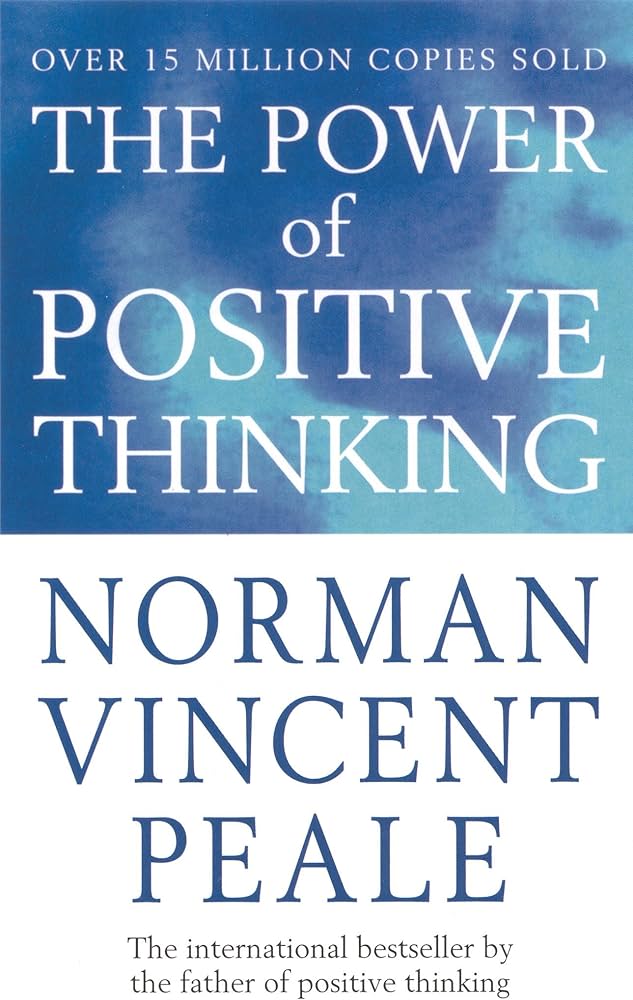Positive Thinking:
Dive into the heart of "The Power of Positive Thinking" where the vibrant energy of optimism breathes life into every page. Norman Vincent Peale, with his eloquent and persuasive style, unravels the profound effect that a shift towards positive thinking can have on our lives. It's not just about seeing the glass as half full; it's a transformative practice that Peale assures can lead to tangible, remarkable changes in one's life.
Peale, with his words, paints a vivid landscape of possibilities: “Change your thoughts, and you change your world.” This simple yet powerful statement encapsulates the essence of the book. It's an invitation to challenge our default patterns of pessimism and to embrace a more hopeful, affirmative outlook on life.
But why does positive thinking matter so much? Peale argues that our thoughts are the architects of our destiny. When we harbor negative thoughts, they build walls around us, limiting our potential. On the flip side, positive thinking opens doors, creates opportunities, and attracts success. It's like planting seeds of optimism in the fertile soil of our minds, which then grow into the fruits of happiness, health, and prosperity.
Through engaging anecdotes and practical advice, Peale guides us on how to cultivate this mindset. He suggests repeating positive affirmations, visualizing success, and believing in our capacity to overcome challenges. It's not about ignoring life's difficulties, but rather about approaching them with a can-do attitude that breeds solutions and sparks joy.
So, as you read through the pages of this motivational book, give yourself over to the alluring power of positive thinking. As Peale beautifully puts it, “Believe in yourself! Have faith in your abilities!” Let these words be the beacon that lights your path to a life filled with confidence, optimism, and triumph.
Self-Confidence:
Embark on a journey through Norman Vincent Peale's "The Power of Positive Thinking" and discover the invigorating world of self-confidence. Peale masterfully articulates that self-confidence isn’t just a trait some are born with; rather, it's a skill cultivated with patience and practice.
"Believe in yourself! Have faith in your abilities!" Peale urges. His words aren't mere suggestions; they are the foundational bricks on the path to a life brimming with confidence. This isn't about unfounded arrogance or blind optimism, but a well-nurtured belief in one's own capabilities.
Peale draws a vivid picture of how low self-confidence can be a major roadblock to success. But fear not! He doesn't leave you stranded in the doldrums of self-doubt. Instead, he offers a treasure trove of strategies to rebuild your self-image. Techniques like positive affirmations and visualization aren't just abstract concepts in this book; they're practical tools. Peale emphasizes, "Change your thoughts, and you change your world." This isn't about altering reality, but about transforming your perception of it.
The most striking aspect is how Peale links self-confidence with peace of mind. He illustrates that when you trust in your abilities, not only do the mountains of challenges seem climbable, but the process of climbing them becomes a source of joy.
Reading this book, one realizes that self-confidence is not a distant dream but a reachable goal. Peale's wisdom is a gentle yet powerful reminder: Your belief in yourself is the key that unlocks potential and fosters an unstoppable spirit of positivity.
The Power of Faith
In "The Power of Positive Thinking," Norman Vincent Peale unveils the profound impact that faith, both in ourselves and in a higher power, can have on our lives. This concept is woven throughout the book, spotlighting faith as a cornerstone for transforming thoughts and actions into a more positive and fulfilling existence.
Peale asserts, “Faith is the most powerful of all forces operating in humanity, and when you have it in depth, nothing can get you down.” This statement encapsulates the essence of his message. Faith is more than just a religious sentiment; it's a dynamic and driving force that propels individuals toward their goals, aspirations, and a deeper understanding of life’s possibilities.
He further illustrates how faith acts as a beacon during times of trouble or doubt. It’s about believing in the unseen, the unproven, and trusting that positive outcomes are not only possible but within reach. This belief isn’t passive; it’s an active, vibrant force that shapes how we perceive challenges and opportunities.
One of the most compelling aspects of Peale's approach is his emphasis on practical application. He suggests that faith, combined with positive action, creates a powerful synergy. By cultivating a deep sense of faith, we can navigate life's tumultuous waters with a sense of peace and purpose. He encourages affirming one’s faith through daily practices and reminders, turning it into a lived experience rather than a mere concept.
Moreover, Peale’s insights about faith extend into the realm of personal potential. He advises, “Believe in yourself! Have faith in your abilities!” This dual focus on self-belief and spiritual faith creates a holistic approach to personal development where one is encouraged to harness the power of both internal and external sources of faith.
Through "The Power of Positive Thinking," Peale offers an enduring message: by fostering a strong sense of faith, we unlock the doors to a life marked by confidence, resilience, and a deep-seated optimism that no obstacle is insurmountable.
The Impact of Attitude
Dive into the energizing world of "The Power of Positive Thinking" where Norman Vincent Peale unlocks the dynamic force that shapes our lives: our attitude. Peale, with his engaging wisdom, illustrates how our attitude is the architect of our reality, painting our experiences with the colors we choose.
"Change your thoughts, and you change your world," declares Peale, encapsulating the essence of this powerful concept. He teaches us that our inner dialogue isn't just a whisper in the recesses of our minds; it's the loudspeaker through which our life story is told. By cultivating a positive attitude, we don't just see the world differently; the world we experience fundamentally changes.
Peale doesn't just preach positivity; he hands us the tools to build it. He encourages us to reshape our internal narratives, to turn the lens through which we view life's challenges from one of despair to one of opportunity and growth. Our attitude, he suggests, is like a magnet—what we emit, we attract. Emit positivity and watch as the world responds in kind.
But Peale is also a realist. He acknowledges the inevitability of negative thoughts and feelings. "It's always too early to quit," he advises, urging us to combat despair with determination and to meet adversity with resilience. This isn't about denying negative emotions; it's about not letting them have the final say.
The journey through this aspect of Peale's work is not just enlightening; it's transformative. It's an invitation to break free from the self-imposed prisons of our negative thoughts and to step into a world where anything feels possible with the right attitude.
Let this book be your guide to flipping the script of your life, showing you that the greatest tool for change is not found in the external world, but within the realms of your own mind. As Peale beautifully puts it, "Believe in yourself! Have faith in your abilities!" And just like that, the doors to a world of endless possibilities begin to open.
Overcoming Negative Thoughts
In the exhilarating journey through "The Power of Positive Thinking," Norman Vincent Peale tackles the universal challenge of negative thoughts with an almost contagious enthusiasm. He empowers readers to confront and conquer their inner critic with an arsenal of positivity.
Peale's approach is refreshingly practical. He suggests that the first step to vanquishing these pesky negative thoughts is acknowledgment, followed by a firm, assertive replacement with positive affirmations. The idea isn't to deny or ignore life's difficulties, but to approach them with a mindset that favors constructive solutions over defeatist attitudes.
One of the most striking aspects of Peale's method is the use of affirmations. He encourages readers to repeat positive phrases like a mantra. For instance, "I can do all things through faith which strengthens me." This affirmation isn't just a feel-good sentence; it's a tool for rewiring the brain towards a more optimistic outlook.
The book is replete with stories of individuals who, by adopting a positive mindset, transformed their fears and doubts into opportunities and successes. Peale doesn't just tell you that positive thinking works; he shows you through real-life examples, making the concept both relatable and achievable.
Another key aspect is the power of belief. Peale insists that belief in oneself acts as a catalyst for change. "Believe in yourself! Have faith in your abilities!" he exclaims, encouraging a self-belief that acts as a shield against the barrage of negativity that life can often throw our way.
Practical Techniques for Daily Living
Dive into the heart of "The Power of Positive Thinking" by Norman Vincent Peale, where the art of transforming your daily life with positivity isn’t just a theory, it's a practice. This section of the book is a treasure trove of actionable strategies, breathing life into the concept of positive thinking through simple, yet powerful, everyday actions.
Firstly, Peale introduces the concept of verbal affirmation. He eloquently puts it, "Change your thoughts and you change your world." It’s all about the power of the spoken word. The book encourages you to start your day by speaking out positive affirmations. These aren’t just words; they’re seeds that, when planted in the fertile soil of your mind, can bloom into a garden of positivity.
Visualization is another key technique. Peale guides you to vividly envision your goals and dreams, not as distant wishes, but as present realities. This technique isn't about daydreaming but creating a mental blueprint for your success. By visualizing your desired outcomes, you align your mental and emotional energy towards achieving them.
Peale also emphasizes the importance of prayer and meditation. He believes in the strength that comes from connecting with a higher power. Whether it’s seeking guidance, finding peace, or expressing gratitude, this practice is about grounding yourself and aligning your spirit with your actions.
Another insightful strategy is the practice of silence. In a world buzzing with noise, Peale highlights the importance of finding moments of quiet. It’s in these moments of stillness that we often find clarity and rejuvenation. As Peale says, "In quiet and silence, the truth is made clear."
Lastly, Peale does not shy away from the reality of obstacles and setbacks. He advocates for facing challenges with a 'can-do' attitude. This isn’t about ignoring difficulties, but rather confronting them with a constructive mindset. By doing so, you transform challenges into stepping stones towards your success.
Each of these techniques, vividly brought to life in Peale's writing, is a tool in your arsenal for positive living. They’re practical, they’re straightforward, and most importantly, they have the power to transform your everyday life into a journey filled with positivity and achievement. As you turn the pages of this enlightening book, you're not just reading; you're embarking on a path of profound personal transformation.

